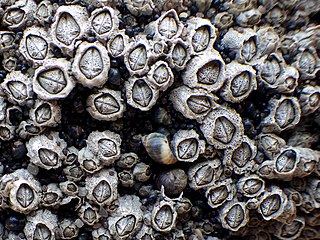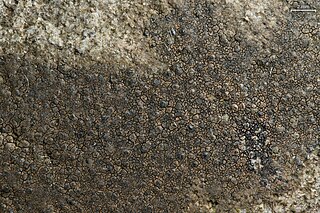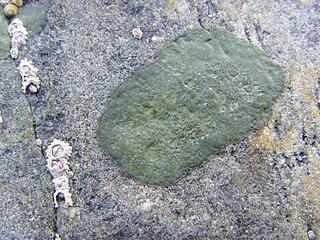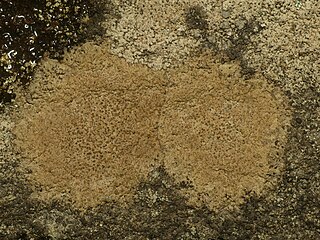
Pseudevernia is a genus of foliose lichens in the family Parmeliaceae. The type species of the genus, Pseudevernia furfuracea, has substantial commercial value in the perfume industry.

Verrucariaceae is a family of lichens and a few non-lichenised fungi in the order Verrucariales. The lichens have a wide variety of thallus forms, from crustose (crust-like) to foliose (bushy) and squamulose (scaly). Most of them grow on land, some in freshwater and a few in the sea. Many are free-living but there are some species that are parasites on other lichens, while one marine species always lives together with a leafy green alga.

Placidiopsis is a genus of lichens in the family Verrucariaceae. The genus was circumscribed by Italian naturalist Francesco Beltramini de Casati in 1858, with Placidiopsis grappae assigned as the type species.

Thelidium is a genus of lichen-forming fungi in the family Verrucariaceae. The genus was circumscribed in 1855 by Italian lichenologist Abramo Bartolommeo Massalongo, who assigned Thelidium amylaceum as the type species.

Flavoparmelia is a genus of foliose lichens in the family Parmeliaceae. Because of their appearance, they are commonly known as greenshield lichens. The widely distributed genus contains 32 species. It was circumscribed by American lichenologist Mason Hale in 1986 to contain 17 former Pseudoparmelia species with broad lobes, usnic acid in the cortex, and isolichenan in the cell walls.

Collemopsidium is a genus of fungi in the family Xanthopyreniaceae. Some members of this genus are marine species, and described as "borderline lichens" or "algicolous" fungi. The genus was circumscribed by Finnish botanist William Nylander in 1881.

Leptogium is a genus of lichen-forming fungi in the family Collemataceae. It has about 110 species. Species formerly classified under Leptogium have since been divided among the genera Leptogium, Pseudoleptogium, and Scytinium. Leptogium lichens are predominantly found on tree bark or soil, often among mosses, and sometimes on rocks in moist environments.
Amundsenia is a genus of saxicolous lichens in the family Teloschistaceae. It has two species. The genus was circumscribed in 2014 by Isaac Garrido-Benavent, Ulrik Søchting, Sergio Pérez-Ortega, and Rod Seppelt, with Amundsenia austrocontinentalis assigned as the type species. The type is known only from continental Antarctica, while Amundsenia approximata only occurs in the Arctic.
Coelopogon is a genus of lichen-forming fungi in the family Parmeliaceae. The genus contains two species found in southern South America and South Africa.

Lichens are symbiotic organisms made up of multiple species: a fungus, one or more photobionts and sometimes a yeast. They are regularly grouped by their external appearance – a characteristic known as their growth form. This form, which is based on the appearance of vegetative part of the lichen, varies depending on the species and the environmental conditions it faces. Those who study lichens (lichenologists) have described a dozen of these forms: areolate, byssoid, calicioid, cladoniform, crustose, filamentous, foliose, fruticose, gelatinous, leprose, placoidioid and squamulose. Traditionally, crustose (flat), foliose (leafy) and fruticose (shrubby) are considered to be the three main forms. In addition to these more formalised, traditional growth types, there are a handful of informal types named for their resemblance to the lichens of specific genera. These include alectorioid, catapyrenioid, cetrarioid, hypogymnioid, parmelioid and usneoid.

Pseudephebe minuscula is a species of fruticose lichen in the family Parmeliaceae. In North America, it is known colloquially as coarse rockwool. It has an antitropical distribution.
Austroplaca is a genus of lichen-forming fungi in the family Teloschistaceae. It has 10 species. The genus was circumscribed in 2013 by Ulrik Søchting, Patrik Frödén, and Ulf Arup, with Austroplaca ambitiosa assigned as the type species.

Pseudocyphellaria glabra is a species of corticolous (bark-dwelling), foliose lichen in the family Peltigeraceae. It has a pale-green upper thallus surface, a white medulla and white pseudocyphellae.
Phylloblastia is a genus of foliicolous (leaf-dwelling) lichens in the family Verrucariaceae. The genus was circumscribed in 1921 by Finnish lichenologist Edvard August Vainio, with Phylloblastia dolichospora assigned as the type species.

Willeya is a genus of saxicolous (rock-dwelling), crustose lichens in the family Verrucariaceae. It has 12 species. Most species are found in southeast Asia, although individual representatives are known from Australia, Europe, and North America.

Wahlenbergiella mucosa is a species of saxicolous (rock-dwelling), crustose lichen in the family Verrucariaceae. It is a marine species that grows in the littoral zone, and therefore remains immersed in seawater for extended periods. Its photobiont partner is the green alga Paulbroadya petersii.
Wahlenbergiella tavaresiae is a species of saxicolous (rock-dwelling), crustose lichen in the family Verrucariaceae. Known from several locations in the San Francisco Bay area of the United States, it is a marine lichen that inhabits intertidal zones, and as such is immersed in seawater on a regular basis. Associated algal species include the red algae Hildenbrandia and Mastocarpus papillatus, and the brown algae Pelvetiopsis and Fucus. Petroderma maculiforme, a brown alga, is the photobiont partner in the lichen.

Ionaspis is a genus of lichen-forming fungi in the family Hymeneliaceae. It contains six species of saxicolous (rock-dwelling), crustose lichens. The genus was originally circumscribed in 1871 by Theodor Magnus Fries. He segregated the genus from Aspicilia based on the presence of Trentepohlia rather than Trebouxia as the photobiont partner.

Opegrapha physciaria is a species of lichenicolous (lichen-dwelling) fungus in the family Opegraphaceae. It was first formally described as a new species in 1897 by Finnish lichenologist William Nylander, who placed it in the genus Lecidea. David Hawksworth and Brian J. Coppins transferred it to the genus Opegrapha in 1992.














